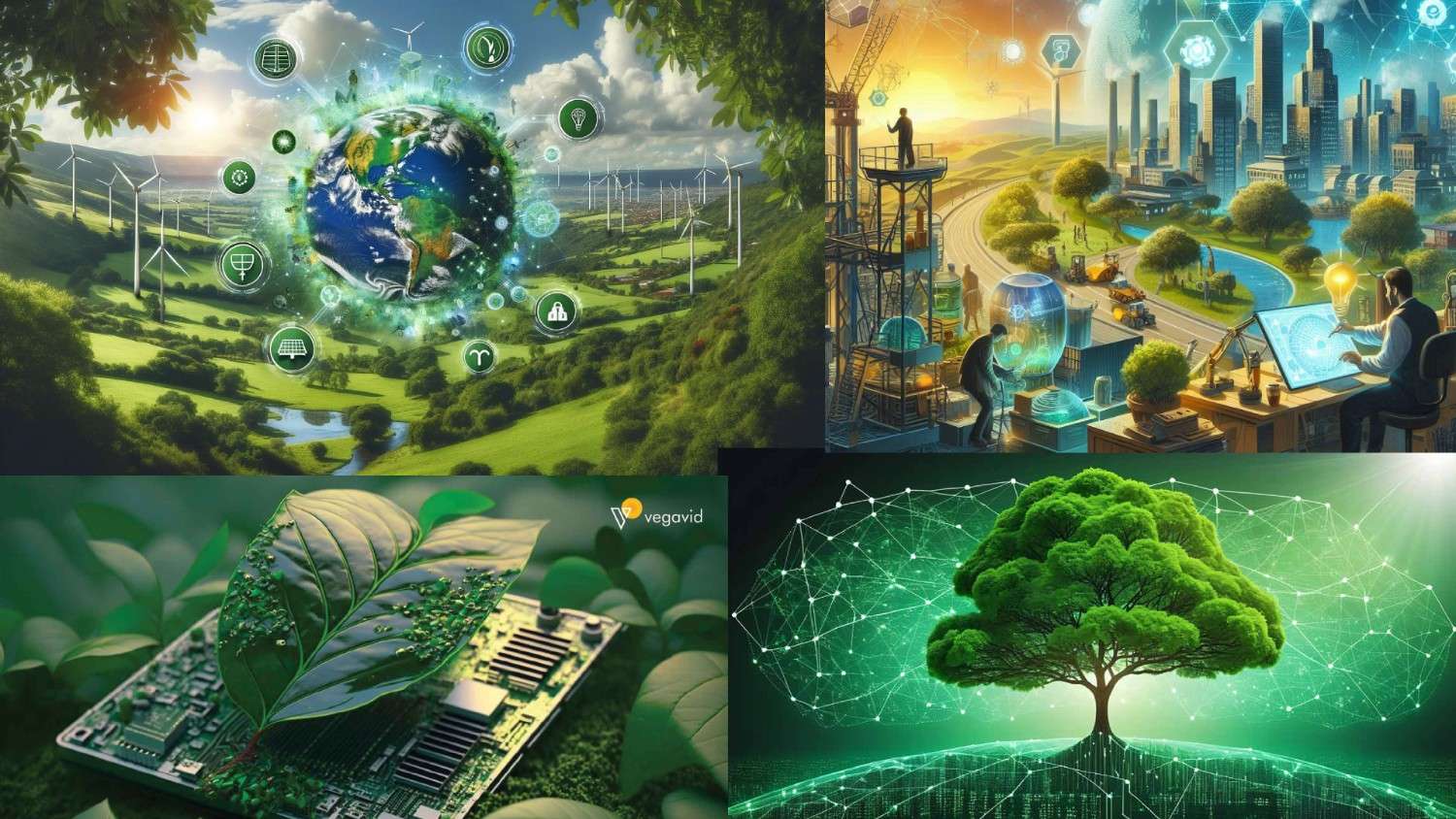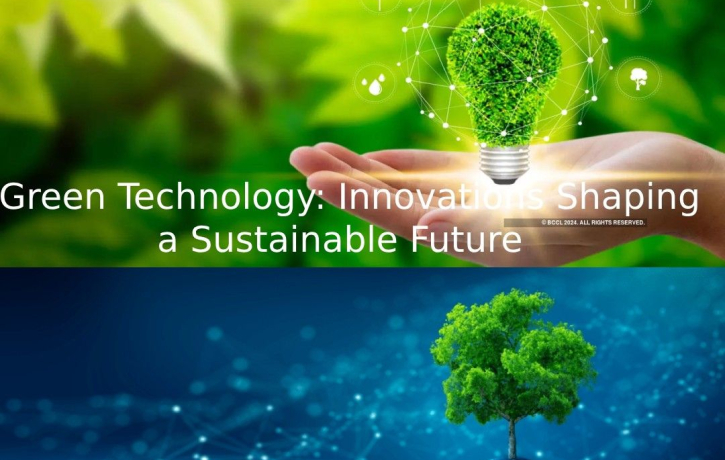- 1 Introduction
- 2 What is Green Technology?
- 3 Renewable Energy Sources
- 4 Electric Vehicles and Sustainable Transportation
- 5 Smart Grids: Effective Energy Management
- 6 Sustainable Agriculture: Responsibly Feed the World
- 7 Water Purification and Conservation Technology
- 8 Green Building Materials and Sustainable Architecture
- 9 Carbon Capture and Storage (CCS)
- 10 Innovation for Recycling and Waste Management
- 11 Green Data Centers: Digital Pollution Reduction
- 12 Biodegradable Plastics and Eco-Friendly Packaging
- 13 Artificial Intelligence for Environmental Monitoring
- 14 Conclusion:

Introduction
The very first aspect of a sustainable future is green technology. It plays a vital role in creating an eco-friendly future. From renewable energy sources to innovations in agricultural sustainability, these green technologies tend to create new techniques that reduce environmental impacts, enhance resource efficiency, and give ways toward a healthier planet. These technologies can help prevent climate change, reduce levels of pollution, and conserve resources.
We will look into new green technologies, and how innovations are pushing them further to help create a sustainable future. Green transportation options, renewable energy solutions, and much more prepared for the most exciting advancements that will pave the way to a greener world.
What is Green Technology?
Green technology, that is to say, clean technology, is a technology with minimum environmental effects or the aim of preserving natural resources. This represents inventiveness in the methods and materials, with energy sources, efficient and environmentally friendly. Green tech solutions solve key environmental challenges: pollution, energy waste, and resource depletion and allow us to gradually move toward better living standards.
Renewable Energy Sources
Powering the Future Renewable sources of energy comprise solar, wind, hydro, and geothermal sources, among others. All these are renewable as they do not derive their power from fossil fuels and are therefore clean sources of power. With the rise of solar panels and solar farms, solar energy was rendered more accessible. Solar power can be generated by allowing strong winds to blow down wind turbines that convert kinetic energy into electricity. These are continually replenished by nature and constitute an essential aspect of reducing carbon emissions and slowing down global warming.
Advantages of Renewable Energy:
- Consume less fossil fuel
- Greenhouse gas emissions reduce
- Gig opportunity in green energy
Electric Vehicles and Sustainable Transportation
Transport is the most significant source of emission; hence, electric vehicles are an imperative green technology. Electric cars operate based on electric motors rather than running on combustion engines; this significantly minimizes pollution and dependence on fossil fuels. Moreover, developments in public transport based on electric buses, high-speed rail, and bike-sharing systems offer green modes of transport for urban mobility and reduce congestion and pollution within cities.
Green Transportation:
- Electric Cars and bikes
- Hydrogen Vehicles
- Electrification of Public Transport
Smart Grids: Effective Energy Management
Traditional power grids are very inefficient, especially with renewable energy sources. Smart grids using advanced forms of monitoring the flow of energy have improved distribution and minimised waste in terms of energy usage. Smart grids enable two-way communication between a utility and consumers. Consumers can have their energy demands adjusted in real time. Efficient management of energy becomes possible with smart grids integrating smart meters and automated systems.
Benefits of Smart Grids:
- Energy wastage reduced
- Enables adjustment with renewable sources of energy
- Makes the grids more reliable and resilient
Sustainable Agriculture: Responsibly Feed the World
Agriculture leads to the destruction of forests, soil depletion, and the emission of dangerous greenhouse gases. Organic farming with sustainability produces food without harming the environment. With techniques in vertical farming, hydroponics, and precision agriculture, it is now possible for farmers to grow crops without abusive use of too much water, energy, and land. While fulfilling the food needs of the world, the agriculture industry can reduce its negative impacts on nature through sustainable means.
Key Sustainable Farming Practices:
- Organic Farming
- No-Till Farming
- Integrated Pest Management
Water Purification and Conservation Technology
Water scarcity is an important challenge and affects billions of people worldwide. Green technology has innovated water purification as well as conservation through the development of innovations within this area. For example, water is now more accessible in desalination plants that convert saltwater to freshwater as well as grey water recycling systems that recycle wastewater from households. Other innovations include smart irrigation systems that conserve water by monitoring soil moisture and are only applicable to a sufficient amount of crops.
Advantages of Water Conservation Technology :
- Improves the availability of clean water
- Reduces water waste in agriculture and industry
- Helps to cope with water scarcity in areas prone to drought
Green Building Materials and Sustainable Architecture
Building accounts for a large proportion of energy usage and carbon emissions. Green building materialism and sustainable architecture aim at having an eco-friendly and energy-efficient structure. Innovations like buildings with integrated solar panels, green roofs, and energy-efficient windows minimize the environment’s harm from the buildings. Sustainable architecture also emphasizes the importance of having passive design maximized as regards natural lighting, ventilation, and insulation whereby heating and cooling through artificial appliances can be reduced.
Examples of Green Building Materials:
- Bamboo with recycled steel
- Insulating concrete forms (ICFs)
- Low VOC paints and finishes
Carbon Capture and Storage (CCS)
Some of the technologies that, so far, have turned out to be vital with the intensification of climate change include carbon capture and storage, which is simply referred to as CCS. This technology consists of the capture of carbon dioxide emissions from their industrial origin and their underground storage, thereby preventing their emission into the atmosphere. This mainly applies to industries like cement and steel production, which cannot easily be decarbonized. The carbon capture and emission storage mitigate the impact of industrial processes on the environment.
Advantages of Carbon Capture:
- Removes carbon
- Aids heavy industries in reducing their carbon footprint
- Respective compensation to renewable energy in accomplishing climate goals.
Innovation for Recycling and Waste Management
Green technology makes a difference in waste management due to new techniques used to reduce the amount of waste sent to landfills. New technologies like advanced recycling and waste-to-energy help reduce waste going into landfills. Plastic-eating bacteria are being researched to break down plastic wastes further, while waste-to-energy is being used at facilities that transform waste into usable energy. All these innovations support a cyclical economy wherein the materials are used repeatedly, repurposed, or recycled with a reduced amount of waste in general.
- Major Innovation in the Waste Management Sector:
- Plastic recycling
- Biodegradable packaging
- Upcycling
Green Data Centers: Digital Pollution Reduction
Data centres are one of the biggest energy consumers because of the rapid surge in digital technology. Green data centres look at reducing the carbon footprint of these establishments through energy-efficient hardware, renewable energy sources, and advanced cooling systems. At such a time, green data centres’ sustainable practices reduce the environmental footprint of the digital world and work towards the eco-friendly goals of companies and organizations across the globe.
Advantages of Green Data Center
- Reduces electricity usage
- Decreases the generation of greenhouse gases
- Fosters environment-friendly technology infrastructure
Biodegradable Plastics and Eco-Friendly Packaging
Plastic pollution is one of the major environmental problems, but biodegradable plastics could be the solution. Being made from materials such as cornstarch, these plastics degrade faster than plastic and hardly create much harm to the environment. Additionally, most companies are now replacing single-use plastics with compostable and recyclable products in the use of eco-friendly packaging.
Eco-Friendly Packaging Examples:
- Plant-based plastics
- Mushroom packing
- Recycled paper and cardboard
Artificial Intelligence for Environmental Monitoring
Artificial intelligence (AI) is revolutionizing how the environment is monitored, say through the real-time analysis of data to inform better decision-making procedures. AI sensors and satellite systems for monitoring air quality, water levels, deforestation, and wildlife populations are very valuable in understanding what gives the push towards conservation drives. The science community and policymakers will be able to fashion more efficient strategies on environmental protection strategies due to the analysis of large volumes of data by AI.
Application of AI in Environmental Protection:
- Wildlife tracking and conservation
- Climate change impact forecasting
- Pollution level monitoring
Conclusion:
Green technology is transforming our way of living, working, and connecting with nature. From renewable energy to electric vehicles to sustainable agriculture to carbon capture, it is reshaping the path to a sustainable future. For example, proper usage of green technologies enables a reduction in the ecological footprint of the earth and preserves natural resources for future generations, keeping the environment clean and healthy.
In this collective journey to sustainability, with every stride green technology takes us closer to the integrated sustainable world: growth in economics that works for the protection of the environment. Let’s move ahead with embracing these innovations, supporting green initiatives, and participating in creating a better and sustainable future.








